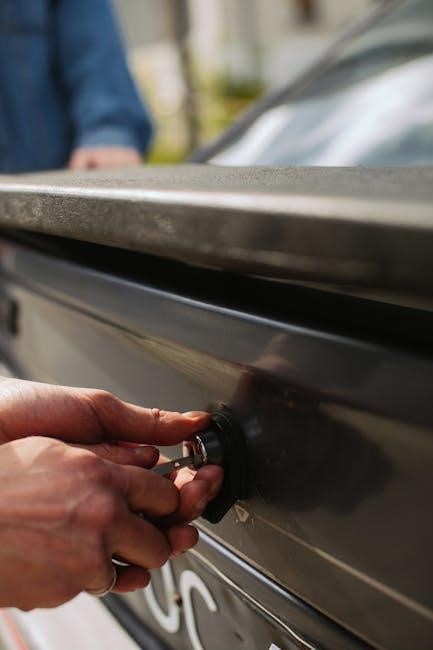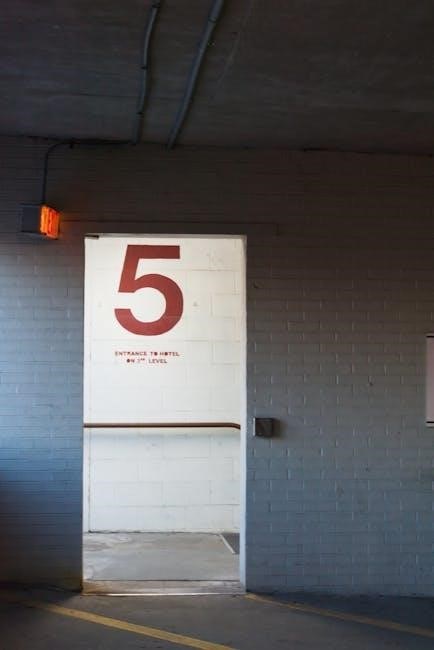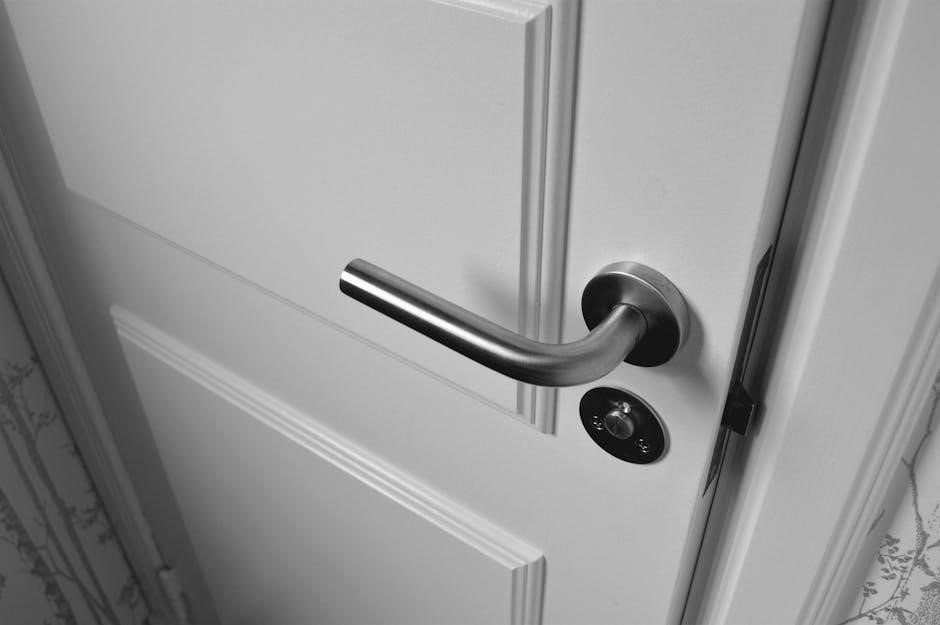Pull the emergency release cord to disengage the door from the opener, then use the manual locking mechanism or install a hasp with a padlock for added security.
Locking your garage door manually provides an extra layer of security, especially during power outages or when the automatic opener malfunctions. This simple process ensures your garage remains secure and prevents unauthorized access. Whether you’re using a traditional locking mechanism, a hasp and padlock, or modern smart locks, manual locking offers peace of mind. It’s essential to familiarize yourself with your garage door’s specific features, such as emergency release cords or manual levers, to lock it effectively. This guide will walk you through straightforward steps to manually secure your garage door, ensuring safety and preventing potential breaches.
Importance of Manual Locking for Garage Door Security
Manual locking is a critical step for enhancing garage door security, offering an additional layer of protection against unauthorized access. It ensures your garage remains secure during power outages or when the automatic opener malfunctions. By engaging manual locks, you prevent potential theft or vandalism, as it adds a physical barrier that automatic systems alone may not provide. This proactive measure gives homeowners peace of mind, knowing their property is safeguarded even when technology fails. Regular use of manual locking mechanisms can also deter intruders, reinforcing your garage door’s overall security system.

Types of Garage Door Locking Mechanisms

Garage doors use slide locks, T-handle locks, or smart locks. Slide locks secure the door to the track, while T-handle locks engage a latch system internally.
For Typical Garage Doors
For typical garage doors, manual locking involves engaging the built-in locking mechanism. Locate the emergency release cord, pull it down to disengage the door from the opener. Next, use the manual lock, often found in the center or sides of the door, to secure it. Some doors feature L-shaped locking bars that slide into the track for added security. Ensure the door is fully closed before locking to prevent gaps. For extra protection, consider installing a hasp and padlock on the door’s edge where it meets the track. This ensures the door remains locked and secure, even manually.
For Roller Garage Doors
For roller garage doors, manual locking typically involves securing the door in place to prevent unauthorized access. Start by ensuring the door is fully closed. Place a C-clamp or vice grip on the track above one of the rollers to prevent movement. Additionally, you can install a hasp and padlock on the door’s edge where it meets the track. This provides an extra layer of security. For added protection, consider using a manual locking bar that fits into the track, ensuring the door cannot be rolled open. Always check the manufacturer’s guidelines to ensure compatibility and avoid voiding any warranties.
For Sectional Garage Doors
Sectional garage doors often feature built-in manual locking mechanisms, making them secure even without electric openers. To lock, locate the L-shaped bars on the edges of the door panels. Slide these bars into the corresponding slots in the track to prevent movement. Additionally, you can engage the emergency release by pulling the red cord, which disengages the door from the opener. For extra security, install a hasp and padlock on the door’s bottom section or use C-clamps on the track above the rollers. Always ensure the door is fully closed before locking to maximize effectiveness and prevent potential breaches.

Troubleshooting Common Issues
Common issues include misaligned tracks, faulty locking mechanisms, or worn-out parts. Check for obstructions, inspect the lock’s condition, and ensure the emergency release cord is fully engaged.
Identifying Common Problems
Common issues when manually locking a garage door include misaligned tracks, faulty locking mechanisms, or worn-out parts. Check for obstructions like debris or uneven tracks that prevent smooth operation. Listen for unusual noises, such as grinding or scraping, which may indicate misalignment. Inspect the locking bar or mechanism for damage or rust. If the door refuses to stay closed, the springs or cables might be loose or broken. Ensure the emergency release cord is fully disengaged and not interfering with manual locking. Lubricate hinges and rollers if they appear stiff. Addressing these issues promptly ensures secure and efficient manual locking.
Practical Solutions
To address common manual locking issues, start by ensuring the door is properly aligned and clear of obstructions. Apply lubricant to hinges and rollers for smooth operation. If the locking mechanism is faulty, replace worn-out parts or tighten loose components. For added security, install C-clamps or vice grips on the track above the rollers to prevent movement. Alternatively, use a hasp and padlock system at the door’s base. Regular maintenance, such as inspecting springs and cables, can prevent future problems. These practical solutions ensure your garage door remains secure and functions efficiently when locked manually.

Locking from the Outside
Install a hasp and padlock system at the door’s base or use a C-clamp on the track to secure the door externally for added protection.
Using a Hasp and Padlock
A hasp and padlock system provides a reliable way to secure your garage door externally. Attach the hasp to the garage door and the frame, ensuring it aligns properly. Close the door, loop the padlock through the hasp, and lock it. This method adds an extra layer of security, especially when combined with internal locking mechanisms. Ensure the hasp is securely screwed into place to prevent tampering; This solution is simple, effective, and works for various garage door types, offering peace of mind when you’re away from home.

Locking from the Inside
Engage the manual locking mechanism by sliding the bolt or flipping the lever inside the garage. This ensures security when the door is closed and the opener is disengaged.
Engaging the Manual Locking Mechanism
Locate the manual locking mechanism, typically found near the garage door motor or along the door’s track. Pull the emergency release cord to disengage the door from the opener. This allows manual control. Next, slide the locking bolt or flip the lever into place to secure the door. Ensure it clicks firmly to confirm it’s locked. This mechanism prevents the door from being opened remotely or by the opener, providing an extra layer of security. Always test the lock by gently pulling the door to ensure it’s properly engaged. This step is crucial for added safety and peace of mind.
Using Additional Security Devices
Bolster your garage door’s security by incorporating extra devices. Install C-clamps or vice grips on the track to prevent rollers from moving. A manual locking bar can be placed across the door for added strength. Consider investing in a smart garage door lock, which offers remote monitoring and keyless entry. Reinforce the door tracks with steel brackets to deter tampering. These supplementary measures enhance manual locking, providing a robust defense against potential breaches. Ensure all devices are securely fitted and test their effectiveness to maintain optimal garage security.

Alternative Security Measures
Enhance security by installing C-clamps, vice grips, or a manual locking bar. Consider smart locks for remote control and reinforce tracks for added protection against breaches.
Installing C-Clamps or Vice Grips
C-clamps or vice grips provide an additional layer of security for your garage door. Simply attach them to the track above the rollers to prevent the door from moving. This method is especially useful during power outages or when the automatic opener is malfunctioning. Ensure the clamps are tightened securely to hold the door in place. This cost-effective solution offers peace of mind, knowing your garage is protected from potential breaches. For maximum security, combine this method with a padlock or manual locking mechanism. This ensures your garage remains secure even in unexpected situations.
Using a Manual Locking Bar
A manual locking bar is a simple and effective way to secure your garage door. Locate the L-shaped locking bars on the edges of the door, near the tracks. Slide the bar into the track to prevent the door from moving. This method is ideal for added security, especially during power outages or when the automatic opener is not functioning. Ensure the bar is fully engaged for maximum protection. This solution is easy to use and provides peace of mind, knowing your garage door is securely locked and cannot be opened easily. It’s a reliable option for manual locking.
Adding a Smart Garage Door Lock
A smart garage door lock offers advanced security and convenience. Operate it via a smartphone app, allowing remote locking and unlocking. Key features include manual override capabilities, real-time notifications, and compatibility with various door types. Installation is straightforward, integrating with existing systems. This solution enhances security and provides peace of mind, especially for those seeking modern, tech-driven protection. It’s ideal for homeowners wanting to monitor and control their garage door from anywhere, ensuring it remains locked when needed. Smart locks are a practical upgrade for added safety and ease of use, making them a popular choice for manual locking solutions.
Reinforcing the Garage Door Track
Reinforcing the garage door track enhances security and stability. Use C-clamps or vice grips to secure the track, preventing the door from being forced open. Ensure the clamps are tightly fastened above the rollers. This method provides an additional layer of protection, especially for manual locking. Regularly inspect the tracks for wear and tear, tightening bolts as needed. A reinforced track system makes the door more resistant to tampering and ensures smooth operation. This simple yet effective method is a practical addition to manual locking, offering long-term durability and improved safety for your garage door.
Manually locking your garage door enhances security and provides peace of mind, especially during power outages or opener malfunctions. By following the outlined methods, such as engaging manual mechanisms, using additional devices, or reinforcing tracks, you can ensure your garage remains secure. Regular maintenance and inspections are key to maintaining effective locking systems. Whether through traditional locks or modern smart solutions, securing your garage door manually is a straightforward process that offers lasting protection. Implement these strategies to safeguard your property effectively and enjoy the benefits of a secure garage door system.
